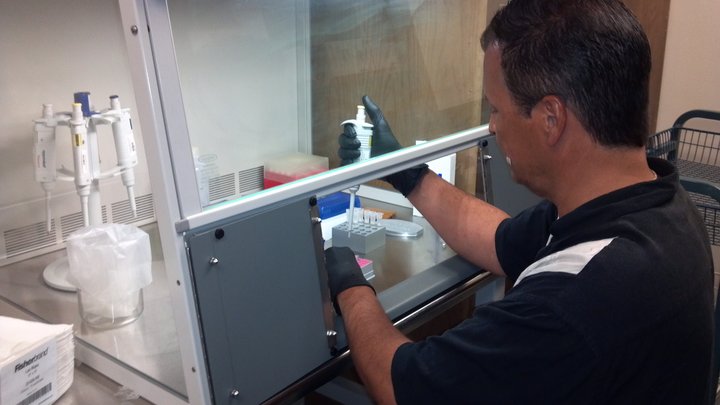
Keith Parker analyzing lamprey DNA at Humboldt State University. Photo: Yurok Tribe.
###
Press release from the Yurok Tribe:
In the most recent edition of the preeminent science journal, Molecular Ecology, Yurok Fisheries Department biologist Keith Parker details his groundbreaking discovery of a previously unidentified Pacific lamprey subspecies on the Klamath River.
“Using a blend of traditional ecological knowledge (TEK) and currently available technology, we were able to verify the existence of genetically distinct, ocean and river-maturing lamprey ecotypes,” said Parker, a Yurok citizen and Molecular/Fisheries Biologist. “It is an honor and a privilege to improve our understanding of this culturally and ecologically important fish species.”
Parker is the lead author of “Evidence for the Genetic Basis and Epistatic Interactions Underlying Ocean- and River-Maturing Ecotypes of Pacific Lamprey (Entosphenus tridentatus) Returning to the Klamath River, California.” Prior to the article’s publication, a team of scholars from Molecular Ecology, an internationally acclaimed periodical, put the technical paper through a rigorous peer-reviewed process.
“I would like to thank my co-authors, Dr. Andrew Kinziger, Dr. John Hess and Dr. Shawn Narum for their commitment to bettering our knowledge of the Klamath River’s imperiled Pacific lamprey populations,” Parker said. “They are some of the best fish geneticists in the world.”
The Pacific lamprey is native to rivers of the West Coast, where populations of these fish have been declining for several decades due to habitat loss, pollution and dams. The snake-shaped lamprey resembles an oceanic eel and is often referred to as such. However, Pacific lamprey are set apart by their unique mouth, a large oral sucking disk filled with sharp teeth surrounding a razor sharp tongue. To produce definitive evidence of the two ecotypes, Parker used a next-generation genetic sequencing technique, at the Columbia Intertribal Fish Commission’s Laboratory in Hagerman, Idaho, to analyze 219 lamprey DNA samples he collected over a 12-month period.
“After genotyping all of the samples, multiple gene locations jumped off the screen. It was extremely exciting to see the genetic differences in the two ecotypes. Depending on the composition of their DNA, one matures in the river and another in the ocean,” Parker explained. “We could even see exactly where their genetic configurations diverged. There are 15 genes acting in a complex interactive relationship that predict whether or not the fish will be in-river or ocean-maturing. Our analysis also identified a strong genetic basis for lamprey body size, involving eight other genes. This finding is remarkable because of the strength of the genetic associations and some these same associations have been observed hundreds of miles away on the Columbia River. I would like to thank the Columbia Intertribal Fish Commission for inviting me to use their genetic sequencing technology and lab.”
As the person responsible for this historic breakthrough, Parker was given the opportunity to name the ecotypes. In all scientific literature, the river-maturing type will now be called key’ween (the Yurok word for Pacific lamprey) and the ocean-maturing type will be referred to as tewol (the Yurok word for ocean). This is an equally unique accomplishment because it is especially uncommon for a species to be formally described in an indigenous language.
“Even though western science and traditional ecological knowledge have significantly contrasting worldviews, TEK is finally becoming recognized as an important and valid tool for use in modern science,” Parker said.
While the lamprey is invaluable to many different Tribal nations, it does not have a recreational or commercial value, which is why it is one of the least studied fish in the Pacific Northwest. There is little funding to perform the type of research that Parker is doing.
“I would like to thank the Columbia River Intertribal Fish Commission, the National Science Foundation and The Robert & Patricia Switzer Foundation for funding this undertaking,” Parker said. “Having access to this nutritionally dense fish during the coldest time of the year, when other foods are scarce enabled our people to prosper for millennia. Prior to European contact, the river was full of fish year-round, which gave us the stability to become world renowned canoe builders and basket weavers. It also allowed our ancestors to develop our complex systems of governance and justice.”
There is an urgent need to better understand the lamprey, which occupies several vital ecological niches throughout its lifecycle. For example, full-grown lamprey are the California sea lion’s preferred food source. These large marine mammals will swim through a school of salmon to get to one eel. Additionally, the large pinnipeds can swallow the calorie-dense lamprey whole without expending much energy. Juvenile lamprey are a vital food source native birds and other fish. These anadromous fish also facilitate the transport of marine nutrients from the ocean to the forests.
“When lamprey are removed from this interconnected system, every other living species suffers, including humans. If anything, I hope my research illuminates the need for additional studies on this essential species,” Parker concluded.
*All of the eels used in the study were donated to elders or eaten by local people.
CLICK TO MANAGE